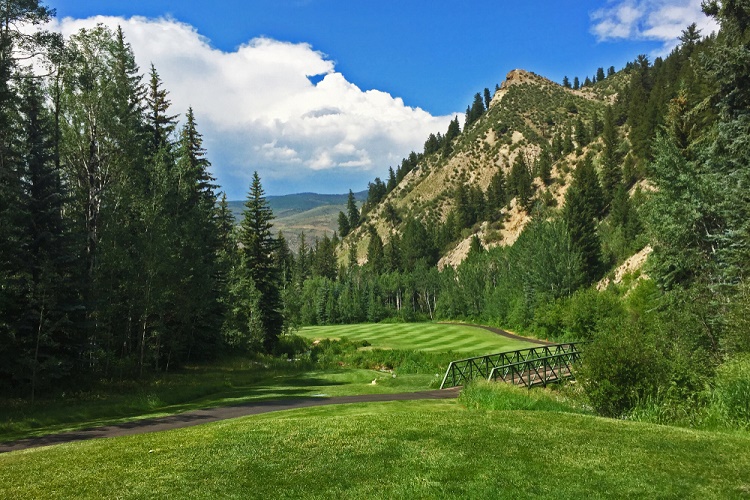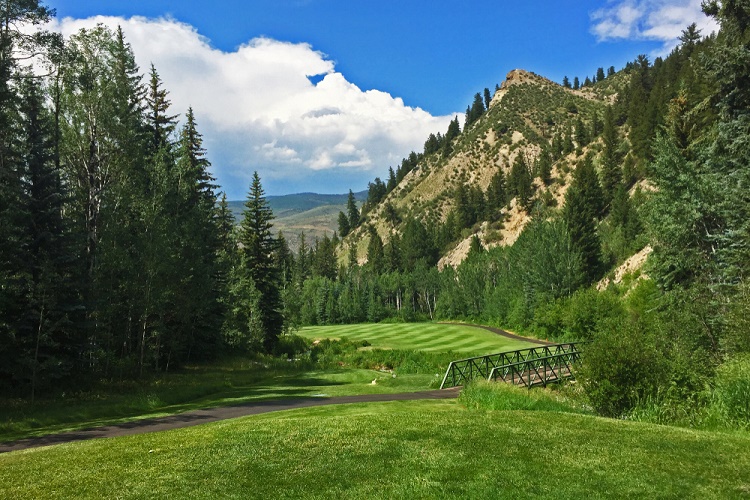Golf course real estate makes a comeback in the mountains
About half the state’s most acclaimed golf courses live in places traditionally considered ski country
Susan Fornoff //March 11, 2020//


Golf course real estate makes a comeback in the mountains
About half the state’s most acclaimed golf courses live in places traditionally considered ski country
Susan Fornoff //March 11, 2020//

Suckers for the hottest new driver and a high-tech ball, golfers will do just about anything for a few more yards. Here in Colorado, we’ve got an option that’s much easier than lessons: Drive up a steep, steep hill and stay awhile.
“We certainly have clients who are looking to buy retirement homes in our golf course resort areas,” says Wendy Tancheff, RE/MAX broker associate (and golfer) in Summit County, home to Breckenridge, Keystone’s two courses and the Raven at Three Peaks. “Avid golfers like the challenge of our mountain courses, and at our higher elevation the golf ball flies farther and straighter than at lower elevations, as there is less air resistance. Our mountain air also offers cooler temperatures in the summer, and it rarely gets above 90 degrees.”
About half the state’s most acclaimed golf courses live in places traditionally considered ski country. Golf Digest’s list of the top 20 Colorado courses includes No. 7 Maroon Creek (Aspen), Nos. 8 and 10 Red Sky Ranch Fazio and Norman courses (Wolcott), No. 9 Roaring Fork (Basalt), No. 12 Country Club of the Rockies (Edwards), No. 13 Frost Creek (Eagle), No. 14 Aspen Glen (Carbondale), No. 16 Catamount Ranch (Steamboat) and No. 20 Cordillera (Edwards). Colorado Avid Golfer readers would add the Keystone courses and Tabernash’s Pole Creek to that list.
All of these have adjacent housing communities, many of which were struggling 10 years ago. In Grand County, Grand Elk’s golf course was on the brink of extinction when its first developer was foreclosed on in 2009; now the course is thriving and surrounded by homes along with new construction at $600,000 and up. And in Pitkin County, $5 million cabins are under construction along Roaring Fork Club’s fairways. “We’re expanding on all fronts of the golf communities,” says Brenda Wild, broker/owner of RE/MAX Signature. “Ten years ago, you could have bought lots for nothing.”
Golf has made such a comeback in the mountains that Wild credits Roaring Fork for a boom beyond those luxury cabins. “There are people who wanted to join the golf club and bought homes elsewhere in Basalt. That has been a great boost for Basalt.”
The purchase of real estate in Aspen Glen and Roaring Fork, Wild says, comes with the requirement to join those golf clubs and thus ensure their survival. “There are many of us who don’t golf,” she says, “but there’s social life, a pool at some clubs, and our wonderful hiking and biking in summer, and of course the skiing in winter.”
The Vail Valley has 11 courses ranging from public to semi-private to private, with something of a hybrid at Red Sky Ranch, which is owned by Vail Resorts and alternates public play by resort guests on one course and member play on the other. Sotheby’s broker/associate Brad Cohn notes that home sales at Red Sky have picked up as the golf courses have gained acclaim; unlike other courses in the region, they do not have proximity to the ski slopes.
“At Cordillera, we saw some pickup as well, maybe because memberships dropped to $45,000 and there are three courses there as well as a par-3,” Cohn says. “Eagle Vail has gone really well. Between Vail and Beaver Creek, it’s a locals’ as well as a second-home market, with a public golf course. We saw a price rise there of 11% in 2019.”
Cohn lives in Singletree, at the 13th tee of the Sonnenalp course that uses the hybrid private/resort model. He’s become used to the occasional curse word and early-morning mower, but says now there’s a new consideration for would be golf-course homeowners: “Everyone is playing music on Bluetooth speakers. When I play golf, I can’t listen to music, so that’s strange to me.”
Those hazards come with golf course real estate anywhere, but when it comes to mountain golf real estate in Colorado, there are unique points to consider:
- The golf season is generally short and never predictable. Most course operators aspire to open by Memorial Day and to stay open into October, which can be a particularly quiet and beautiful month for mountain golf. But there are many variables. Cordillera’s Summit Course peaks at 9,200 feet, so it often does not open before July 4. Elsewhere in the Vail Valley, where a course is situated in relation to sunshine impacts the length of its season.
- Many of the mountain golf courses require players to ride carts, because of either elevation changes or long distances from green to tee. Courses considered walker-friendly include Aspen Glen and Aspen, Eagle Ranch, Grand Elk and Vail; Eagle Vail, the Norman at Red Sky, Beaver Creek and Granby Ranch are considered walker-averse. Elsewhere, do your homework.
- Golfers who buy homes in ski country stand a better chance to make their money back in the winter than skiers who buy homes in ski country do. Mary Waldman at Summit Mountain Rentals reports that even golf course homes in the Breckenridge-Keystone-Raven corridor make about 80 percent of their rental revenue in the winter. “It is without a doubt the busier time, and I do not see anything to suggest a change from the 80/20 split.” Furthermore, Waldman says, “I have seen no example that a home on the golf course charges a summer premium for that location or that they see higher summer occupancy.” So the golfer might as well live in the mountain home in golf season and rent it out the rest of the year.
- A Home’s value as a winter rental depends on its access to the slopes. Where are the lifts, and what are the bus routes? “Vail Golf Course is a public course that has homes around it, and that neighborhood’s one of my favorites because the town bus takes you directly to the Golden Peak ski lift,” Cohn says. “The other buses take you into Vail Village, where you’re walking through town to the lift.”
Of course, the sweet spot for many is this: The Gypsum Creek golf course, less than an hour from Vail, often can open as early as March, thus creating the possibility of a few runs in the morning and 18 holes in the afternoon. It happens in Aspen as well. “I think last year we had skiing Fourth of July weekend,” Wild says. “For some people, to get to ski in the morning and golf in the afternoon is the crowning touch of their ski season.”



























